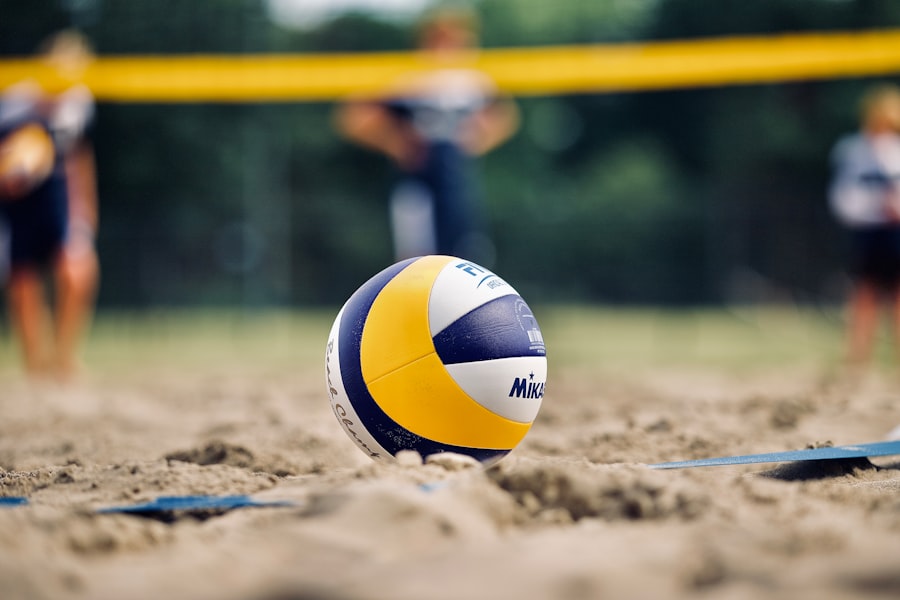Mastering Volleyball: Tips for Success
Description
Volleyball is a dynamic sport that combines elements of athleticism, strategy, and teamwork. Originating in the United States in 1895, it has evolved into a global phenomenon, played on both indoor courts and sandy beaches. The game is played between two teams, each consisting of six players, who aim to score points by sending a ball over a net and into the opposing team’s court.
The fundamental objective is to prevent the ball from touching the ground on one’s own side while attempting to make it land on the opponent’s side. This simple yet engaging premise has captivated millions, making volleyball one of the most popular sports worldwide. The court dimensions are standardized, measuring 18 meters long and 9 meters wide, divided by a net that stands at a height of 2.43 meters for men and 2.24 meters for women.
Each team has three front-row players and three back-row players, with specific roles that contribute to both offensive and defensive strategies. The game is played in sets, typically best-of-five, where teams must reach 25 points to win a set, with a minimum two-point lead required. Understanding these basic rules and structures is crucial for anyone looking to delve deeper into the sport, as they form the foundation upon which more advanced skills and strategies are built.
Key Takeaways
- Volleyball is a team sport played with a ball and a net, with the objective of sending the ball over the net and into the opponent’s court.
- Proper technique and form are essential for successful volleyball play, including proper hand positioning, body posture, and footwork.
- Improving footwork and agility is crucial for quick movements and effective positioning on the court.
- Mastering serving and receiving involves developing a consistent and powerful serve, as well as honing the skills to effectively receive and control the ball.
- Communication and teamwork are key components of successful volleyball play, requiring clear and effective communication among team members and coordinated efforts to achieve the team’s goals.
- Effective blocking and spiking strategies involve understanding the opponent’s movements and positioning, as well as developing powerful and accurate spiking techniques.
- Mental preparation and focus are important for maintaining concentration and composure during intense volleyball matches.
- Conditioning and injury prevention are essential for maintaining physical fitness and preventing common volleyball-related injuries.
Developing Proper Technique and Form
Passing Technique
For instance, when performing a pass or a set, players must ensure their body positioning is optimal. A common technique for passing is the forearm pass or “bump,” where players should keep their arms straight and together, forming a platform to direct the ball accurately. The knees should be slightly bent, and players must use their legs to generate power rather than relying solely on their arms. This technique not only enhances accuracy but also minimizes the risk of injury.
Serving Technique
In addition to passing, serving is another critical skill that demands attention to technique. A well-executed serve can set the tone for a rally. Players often practice different types of serves, such as the underhand serve for beginners or the more advanced jump serve for experienced players.
Mastering Techniques through Repetitive Drills
The jump serve involves a coordinated approach where players must time their jump perfectly to strike the ball at its highest point. This requires not only physical strength but also precise timing and body control. Coaches often emphasize repetitive drills to help players internalize these techniques, ensuring that they can perform them instinctively during matches.
Improving Footwork and Agility

Footwork is an often-overlooked aspect of volleyball that plays a pivotal role in a player’s overall performance. Effective footwork allows players to position themselves optimally for receiving serves, making passes, or preparing for attacks. Quick lateral movements are essential for both defense and offense; therefore, drills focusing on agility can significantly enhance a player’s ability to move swiftly across the court.
For example, ladder drills can improve foot speed and coordination, while cone drills can help players practice changing direction quickly. Moreover, proper footwork contributes to balance and stability during play. When attacking or blocking, players must be able to plant their feet firmly while maintaining readiness to move in any direction.
This balance is crucial when executing powerful spikes or effective blocks against opponents’ attacks. Coaches often incorporate plyometric exercises into training regimens to develop explosive power in the legs, which translates into improved jumping ability and overall agility on the court.
Mastering Serving and Receiving
| Player | Aces | Double Faults | 1st Serve Percentage | 1st Serve Points Won | 2nd Serve Points Won |
|---|---|---|---|---|---|
| Player 1 | 10 | 5 | 65% | 80% | 60% |
| Player 2 | 8 | 3 | 70% | 75% | 55% |
Serving is one of the most critical skills in volleyball, as it initiates each rally and can significantly influence the game’s momentum. There are various serving techniques, including the float serve, jump serve, and topspin serve, each with its unique advantages. The float serve is characterized by its unpredictable trajectory due to minimal spin, making it challenging for opponents to receive accurately.
Conversely, the jump serve generates speed and power but requires precise timing and technique to execute effectively. Receiving serves is equally important; it sets the stage for the team’s offensive play.
Effective communication among teammates during this phase is vital; players should call for the ball loudly to avoid confusion and ensure that everyone knows their responsibilities.
Enhancing Communication and Teamwork
Volleyball is inherently a team sport that thrives on effective communication and collaboration among players. Each member of the team has specific roles that contribute to both offensive and defensive strategies; thus, clear communication is essential for success. Players must develop a common language on the court, using verbal cues and hand signals to indicate plays or strategies during matches.
This level of communication fosters trust among teammates and enhances overall performance. Teamwork extends beyond mere communication; it involves understanding each player’s strengths and weaknesses. Coaches often encourage team-building exercises that promote camaraderie and mutual respect among players.
For instance, small-group drills can help players learn how to work together effectively in various game situations. By fostering an environment where players feel comfortable sharing feedback and supporting one another, teams can develop a cohesive unit capable of executing complex strategies during high-pressure moments in matches.
Strategies for Effective Blocking and Spiking

Blocking and spiking are two of the most exciting aspects of volleyball that require both skill and strategy. Effective blocking involves anticipating the opponent’s attack and positioning oneself correctly at the net to intercept the ball. Players must time their jumps perfectly while keeping their hands high above the net to create an effective barrier against spikes.
Coaches often emphasize the importance of reading the hitter’s approach; by observing their body language and footwork, blockers can better predict where the ball will be directed. Spiking, on the other hand, is an aggressive offensive move aimed at scoring points by hitting the ball forcefully into the opponent’s court. A successful spike requires not only power but also precision; players must aim for gaps in the defense while ensuring their timing aligns with their setter’s delivery.
Various spiking techniques exist, including cross-court spikes and line shots, each serving different strategic purposes depending on the defensive setup of the opposing team. Practicing these techniques through targeted drills allows players to refine their skills and develop a diverse arsenal of attacking options.
Mental Preparation and Focus
Mental preparation is an often underestimated aspect of volleyball that can significantly impact performance on the court. Athletes must cultivate mental resilience to handle pressure situations effectively, especially during crucial points in matches. Visualization techniques can be beneficial; players often imagine themselves successfully executing skills or winning critical rallies before stepping onto the court.
This mental rehearsal helps build confidence and reduces anxiety. Focus is equally important; distractions can derail performance during high-stakes moments. Players should develop routines that help them center their thoughts before serving or receiving the ball.
These routines might include deep breathing exercises or specific pre-play rituals that signal readiness to compete. Coaches frequently work with athletes on mental conditioning strategies that enhance concentration and promote a positive mindset throughout training sessions and competitions.
Conditioning and Injury Prevention
Conditioning plays a vital role in a volleyball player’s overall performance and longevity in the sport. A well-rounded conditioning program should include strength training, cardiovascular fitness, flexibility exercises, and sport-specific drills tailored to volleyball’s demands. Strength training focuses on building muscle groups essential for jumping, hitting, and quick lateral movements; exercises such as squats, lunges, and core workouts are commonly incorporated into training regimens.
Injury prevention is another critical aspect of conditioning that cannot be overlooked. Volleyball players are susceptible to various injuries due to repetitive motions and high-impact landings associated with jumping. Implementing proper warm-up routines before practices or matches can significantly reduce injury risk; dynamic stretching helps prepare muscles for activity while increasing blood flow.
Additionally, educating athletes about proper landing techniques can minimize stress on joints during high-impact plays. By prioritizing conditioning alongside injury prevention strategies, players can enhance their performance while ensuring they remain healthy throughout their volleyball careers.
FAQs
What is volleyball?
Volleyball is a team sport in which two teams of six players each are separated by a net. The objective is to score points by grounding the ball on the opposing team’s court.
What are the basic rules of volleyball?
The basic rules of volleyball include serving the ball over the net, rallying to keep the ball in play, and trying to score points by grounding the ball on the opposing team’s court. Each team is allowed three touches to return the ball over the net.
What are the different types of volleyball games?
There are several different types of volleyball games, including indoor volleyball, beach volleyball, and sitting volleyball. Each type has its own specific rules and variations.
What are the key skills needed to play volleyball?
Key skills needed to play volleyball include serving, passing, setting, attacking, blocking, and digging. Players also need good communication and teamwork skills to be successful in volleyball.
What is the history of volleyball?
Volleyball was invented in 1895 by William G. Morgan, a YMCA physical education director, in Holyoke, Massachusetts. It was originally called “mintonette” and was designed as a less strenuous alternative to basketball for older members of the YMCA.
What are the health benefits of playing volleyball?
Playing volleyball can provide a range of health benefits, including improved cardiovascular fitness, increased muscle strength and endurance, enhanced agility and coordination, and improved mental focus and concentration. It also promotes teamwork and social interaction.
What are the different positions in volleyball?
The different positions in volleyball include setter, outside hitter, opposite hitter, middle blocker, libero, and defensive specialist. Each position has specific roles and responsibilities on the court.





